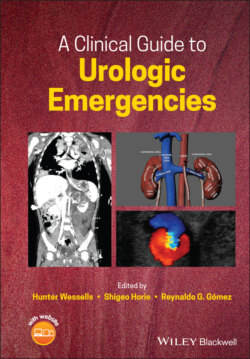Читать книгу A Clinical Guide to Urologic Emergencies - Группа авторов - Страница 40
Evaluation
ОглавлениеThe initial evaluation and management of trauma patients has been standardized according to set protocols with the development of the Advance Trauma Life Support (ATLS) guidelines. Thus, the initial management of the trauma patient has often been completed by the trauma team prior to the involvement of a urologist [19, 20]. Vitals sign monitoring is imperative in patients with PRI, as patient stability dictates management.
For suspected renal trauma, the evaluation should include a thorough history and physical examination to evaluate for penetrating entry and exit wounds, flank ecchymosis, rib fractures, and gross hematuria. In addition to standard laboratory testing, a urinalysis should be obtained to evaluate for microscopic hematuria – defined as three or more red blood cells per high power field. Hematuria is the best indicator of significant renal trauma; however, it is not a sensitive marker, as up to 20.8% of patients with renal trauma lack hematuria [21, 22].
